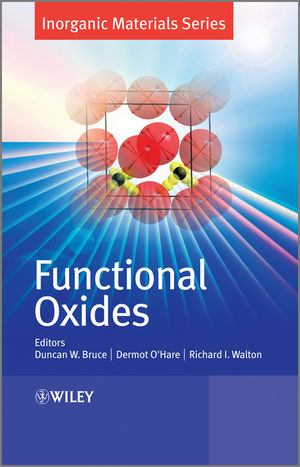Functional OxidesISBN: 978-0-470-99750-5
Hardcover
320 pages
June 2010
 Other Available Formats: E-book
|
||||||
Preface xi
List of Contributors xiii
1 Noncentrosymmetric Inorganic Oxide Materials: Synthetic
Strategies and Characterisation Techniques 1
P. Shiv Halasyamani
1.1 Introduction 1
1.2 Strategies toward Synthesising Noncentrosymmetric Inorganic Materials 3
1.3 Electronic Distortions 4
1.3.1 Metal Oxyfluoride Systems 8
1.3.2 Salt-Inclusion Solids 9
1.3.3 Borates 11
1.3.4 Noncentrosymmetric Coordination Networks 12
1.4 Properties Associated with Noncentrosymmetric Materials 16
1.4.1 Second-Harmonic Generation 18
1.4.2 Piezoelectricity 21
1.4.3 Pyroelectricity 25
1.4.4 Ferroelectricity 27
1.5 Outlook – Multifunctional Materials 30
1.5.1 Perovskites 31
1.5.2 Hexagonal Manganites 32
1.5.3 Metal Halide and Oxy-Halide Systems 32
1.6 Concluding Thoughts 33
1.6.1 State of the Field 33
Acknowledgements 34
References 34
2 Geometrically Frustrated Magnetic Materials 41
John E. Greedan
2.1 Introduction 41
2.2 Geometric Frustration 42
2.2.1 Definition and Criteria: Subversion of the Third Law 42
2.2.2 Magnetism Short Course 43
2.2.3 Frustrated Lattices – The Big Four 46
2.2.4 Ground States of Frustrated Systems: Consequences of Macroscopic Degeneracy 46
2.3 Real Materials 52
2.3.1 The Triangular Planar (TP) Lattice 52
2.3.2 The Kagome´ Lattice 57
2.3.3 The Face-Centred Cubic Lattice 72
2.3.4 The Pyrochlores and Spinels 76
2.3.5 Other Frustrated Lattices 105
2.4 Concluding Remarks 108
References 109
3 Lithium Ion Conduction in Oxides 119
Edmund Cussen
3.1 Introduction 119
3.2 Sodium and Lithium b-Alumina 126
3.3 Akali Metal Sulfates and the Effect of Anion Disorder on Conductivity 132
3.4 LISICON and Related Phases 145
3.5 Lithium Conduction in NASICON-Related Phases 155
3.6 Doped Analogues of LiZr2(PO4)3 164
3.7 Lithium Conduction in the Perovskite Structure 175
3.7.1 The Structures of Li3xLa2/3xTiO3 181
3.7.2 Doping Studies of Lithium Perovskites 185
3.8 Lithium-Containing Garnets 187
References 197
4 Thermoelectric Oxides 203
Sylvie Hébert and Antoine Maignan
4.1 Introduction 203
4.2 How to Optimise Thermoelectric Generators (TEG) 204
4.2.1 Principle of a TEG 204
4.2.2 The Figure of Merit 207
4.2.3 Beyond the Classical Approach 210
4.3 Thermoelectric Oxides 213
4.3.1 Semiconducting Oxides and the Heikes Formula 215
4.3.2 NaxCoO2 and the Misfit Cobaltate Family 221
4.3.3 Degenerate Semiconductors 240
4.3.4 All-Oxide Modules 249
4.4 Conclusion 251
Acknowledgements 252
References 252
5 Transition Metal Oxides: Magnetoresistance and
Half-Metallicity 257
Tapas Kumar Mandal and Martha Greenblatt
5.1 Introduction 257
5.2 Magnetoresistance: Concepts and Development 258
5.2.1 Phenomenon of Magnetoresistance: Metallic Multilayers and Anisotropic Magnetoresistance (AMR) 258
5.2.2 Giant Magnetoresistance (GMR) Effect 259
5.2.3 Colossal Magnetoresistance (CMR) in Perovskite Oxomanganates 261
5.2.4 Tunnelling Magnetoresistance (TMR) and Magnetic Tunnel Junctions (MTJ) 263
5.2.5 Powder, Intrinsic and Extrinsic MR 263
5.3 Half-Metallicity 264
5.3.1 Half-Metallicity in Heusler Alloys 264
5.3.2 Half-Metallic Ferro/Ferrimagnets, Antiferromagnets 265
5.4 Oxides Exhibiting Half-Metallicity 266
5.4.1 CrO2 266
5.4.2 Fe3O4 and Other Spinel Oxides 268
5.4.3 Perovskite Oxomanganates 270
5.4.4 Double Perovskites 272
5.5 Magnetoresistance and Half-Metallicity of Double Perovskites 273
5.5.1 Double Perovskite Structure 273
5.5.2 Ordering and Anti-Site (AS) Disorder in Double Perovskites 276
5.5.3 Electronic Structure and Magnetic Properties of Double Perovskites 281
5.5.4 Magnetoresistance and Half-Metallicity in Double Perovskites 284
5.5.5 High Curie Temperature (TC) Double Perovskites and Room Temperature MR 285
5.6 Spintronics – The Emerging Magneto-Electronics 286
5.7 Summary 288
Acknowledgements 289
References 289
Index 295



